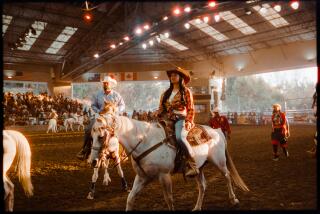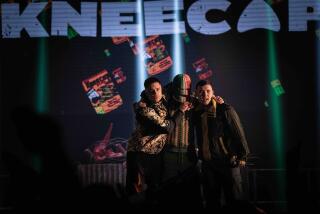Urban Cowboys
- Share via
DUBLIN — They gallop bareback through city streets, scruffy kids on scruffy horses, the slums and mountains of Dublin at their backs.
“Gerrup. . . !” they cry, yanking on crude ropes that pass for reins, digging their sneakers harder into the ribs of their skinny steeds. “Faster, boy, faster!”
Thundering across the urban prairie, the hooves crunch the debris of the night before: discarded heroin needles, beer cans, broken bottles.
Past the grimy concrete towers they race, past the burned-out shells of stolen cars and the dank, foreboding stairwells smeared with graffiti and stinking of human waste; past the wailing babies and howling dogs and tough-looking vigilantes that scour the apartment blocks for drug dealers and their wares.
Ghetto kids whipping ghetto ponies through a high-rise project, where 20,000 people live in government flats and crudely painted bedsheets flap from the rooftops: “Drug dealers get out. No heroin sold here.”
Ballymun. Dublin’s drug capital. Home of the urban cowboys.
It started simply enough, with the revival of Dublin’s inner-city horse market in the late 1980s, perhaps linked to the government’s attempt to settle itinerant travelers, or gypsies, around the city.
Soon gypsy ponies began wandering into the poor neighborhoods, into Tallaght and Finglas and Coolock and Ballymun. And the cowboys started buying and breeding. Today, the patches of scrub originally built as football fields are home to hungry herds. You see them limping down busy roads, foraging for food, tethered to rusting goal posts, squeezed into living rooms and backyards the size of horse boxes.
There are hundreds, maybe thousands, of these “urban horses,” and they’ve become such a problem that the government has passed a law to round them up for good.
The cowboys are ready for a showdown.
Ireland’s horse culture is as old and rich as its heather-covered bogs. From the working shires that lumber through Dublin, carting barrels of Guinness and sacks of coal, to the sleek Thoroughbreds racing across the flatlands of County Kildare, to the sturdy little ponies that pull the caravans of travelers, horses are part of the country’s history and life.
But the Ballymun broncos are a new phenomenon, one the traditional horse culture shuns. Undernourished and often mistreated, they’re a far cry from the mythical creatures portrayed in movies like “Into the West,” where a snow-white stallion brings beauty and joy into a poor child’s life.
These cowboys and their horses, bought cheap from shady dealers, have little of either.
“The government’s got an answer for the horses,” says Vicky McElligott, a tough-talking Ballymun matriarch with nine children, some with children of their own, most with ponies. “What’s their answer for our children?”
The newspapers chart the slaughter: the drug overdoses, the suicides, an unemployment rate of up to 80%, the killings--human and animal.
About two horses a week are put out of their misery in Dublin projects by animal welfare agencies, some shot in the streets by veterinarians as their young owners look on. Others drop dead from hunger and disease. Hundreds more are rounded up and herded off to city pounds.
The roundups take place in the dead of night when the cowboys are sleeping. It’s too dangerous to confront them in daylight.
“People seem to think they have a divine right to own a horse regardless of where they live,” says Therese Cunningham, director of the Dublin Society for the Prevention of Cruelty to Animals, sitting in her cozy office in the hills, a couple of rescued horses grazing comfortably outside.
“They say horses are part of our Irish culture that goes back to the mists of time,” she says. “It’s not part of your culture if you were born in a 15-story block of flats.”
Cunningham is the main force behind the new Control of Horses Act, which requires all horses to be licensed, increases penalties for animal cruelty and bans the sale of horses to children under the age of 16. The goal is clear: Get rid of the urban horses.
“Holy Saint Therese!” jeer the cowboys, as they stoke a stubborn bonfire outside the Ballymun corral. “Would yer listen to that woman? Sure, she’ll save all the poor ponies in Dublin herself.”
The corral is a rundown, corrugated iron shed originally built as a workingmen’s club and shut down when it couldn’t get a liquor license. It’s been converted into makeshift stables for about 20 horses. They have names like Elvis and Rocky and Billy-the-Kid and are guarded by unemployed fathers who while away their days smoking and storytelling and keeping a watchful eye for the posses from the pound.
The corral makes a bold stab at legitimacy: Horse owners are asked to contribute a few pounds a week, and its official name, scrawled in a hand-painted sign over the entrance, is “The Ballymun Horseowners Association.”
In reality, the place is as illegal as the horses on government land. The squatters don’t care. They’ll stay until they get a better deal for their kids. Sure, their horses aren’t as pretty as the polo ponies in Phoenix Park. But they’re keeping the kids out of trouble, away from drugs and boredom and stealing cars for kicks.
“If it wasn’t for the horses, I’d probably be on the gear, on heroin,” says David Thomas, 13, trotting into the corral on a scrappy chestnut filly called Sally. “There’s nothin’ else to do ‘round here.”
McElligott offers a more philosophical argument to anyone who will listen.
“We’re a nation that churns out Thoroughbreds and racehorses that are sold all over the world,” she says, gleefully nailing a couple of plainclothes cops as they drive past the corral.
“Why should horses be just for the rich?” she demands, as they stare back, stone-faced, from the cruiser. “Who has the right to chase horses away from us just because we are poor?”
The cowboys cheer. The law be damned, they shout. We’re not surrendering without a fight.
The cops shake their heads and drive on.
Cunningham gets impatient with the stories that portray her as the villain, the chain-smoking sheriff hounding young cowboys.
“They make it sound so romantic,” she says. “It’s not romantic for the poor horse.”
The DSPCA’s daily log documents the suffering: a blind horse abandoned in a public park, a herd of frightened ponies charging motorists on a busy road, a stampeding colt that tripped over a child’s carriage, knocking the baby to the ground.
Cunningham points to the gangs that break into the pounds and steal back the horses rather than pay the government fines, co-workers driven out of their homes after smoke bombs were flung through their letter boxes and fires set in their cars, thugs who hurled iron horseshoes at her at the Smithfield market, where the horses are bought and sold.
“We’re not trying to take horses from underprivileged kids,” she says. “We are trying to save animals that are abused and abandoned and ridden into the ground by children who don’t know the first thing about caring for a pony.”
But the battle is taking its toll. Cunningham doesn’t go to Smithfield anymore.
The first Sunday of each month, cowboys come from miles around to gather in the dusty cobblestone square in the heart of the city, riding horses they’ll trade in for faster, bigger models. The dealers stream in with horse boxes and caravans.
By noon there are 2,000 horses, snorting and whinnying and stamping as the cowboys shout and barter. Deals are sealed with a spit on the palm and a slap on the back. There isn’t a saddle or stirrup in sight.
Horses sell for anywhere from $80 to $400, depending on their condition and a child’s ability to pay. “Confirmation money,” the cowboys say, straight-faced, when asked how they can afford a horse. “Me ma gave me the money.”
Smithfield is as illegal as nearly everything else to do with the urban horses, but it’s too dangerous to break up the market.
For one thing, the cowboys hate the government-sponsored horse pounds even more than they hate “Saint Therese.” They trade war stories around all-night bonfires if they get tipped about a roundup.
After a raid, the younger cowboys sometimes go to the pound and try bargaining for their horses. It helps if their da’s come too.
The older ones fight back their own way--with crowbars and gangs. They steal back their horses as soon as it’s safe--usually in the middle of the night.
Before the heroin, and long before the horses, Ballymun was considered something of an urban marvel, a decent bit of housing for the poor, far removed from the desperate poverty of the tenements being torn down in the city. Built as a social experiment in the 1960s, the towers were named after the martyred rebel heroes of the Easter 1916 revolt: Plunkett, Connolly, Pearse.
“Them flats were beautiful, when I first moved in,” says McElligott, who reared all her children in Ballymun. “I had central heating galore and all the hot water I wanted.”
She speaks with pride of the enduring community spirit, “neighbors that would lend you their last shilling.” She sees a glimmer of hope in the fact that people are finally talking about the plight of the urban cowboys. There are even rumors that “a wealthy establishment type” will build a center for the children and their ponies.
But no one knows what will come of it, and McElligott has little faith in the future. She tells her children the only way out is to emigrate.
They’re all still here, rearing families in the flats, riding horses through the slums, dreaming of when life will be different.
“We’re getting out of this kip!” cry the cowboys.
“We’ll get a plane to America!” they shout, galloping across the fields toward the airport runway, where the green Aer Lingus jets lift off to London and New York. “We’ll be jockeys and be famous!”
Over the ditch and onto the football field they fly, a ragged pack of warriors who should still be at school.
Yelling. Whooping. Cursing. Smoking.
“Ciaran, you’re a flier! Would you look at him go?”
At 10 years old, with a stallion in your hands and the wind whipping your face, it’s easy to dream you’re a cowboy--like John Wayne in the Wild West, or maybe a famous jockey like Lester Piggott tearing down the raceway at Phoenix Park.
Anywhere but the badlands of Ballymun.
More to Read
Sign up for Essential California
The most important California stories and recommendations in your inbox every morning.
You may occasionally receive promotional content from the Los Angeles Times.










